Home / Resources
Resources
Discover a Wealth of BPM Knowledge and Expertise at BPMInstitute.org!

Getting Started is Hard to Do
At this point, the business benefits of business process management seem clear. Virtually every sector of society, including areas that seem relatively impervious to dramatic change, such as higher education and government, are becoming much more outcome-oriented....

Governance is Key to BPM Success
If all you want to do is execute a one-time improvement to a small business process then governance issues may not be high on your agenda. But if you wish to fully leverage the power of BPM and apply the key principles and practices to your company’s large business processes, you will soon discover that governance is the cornerstone to sustainable BPM success.
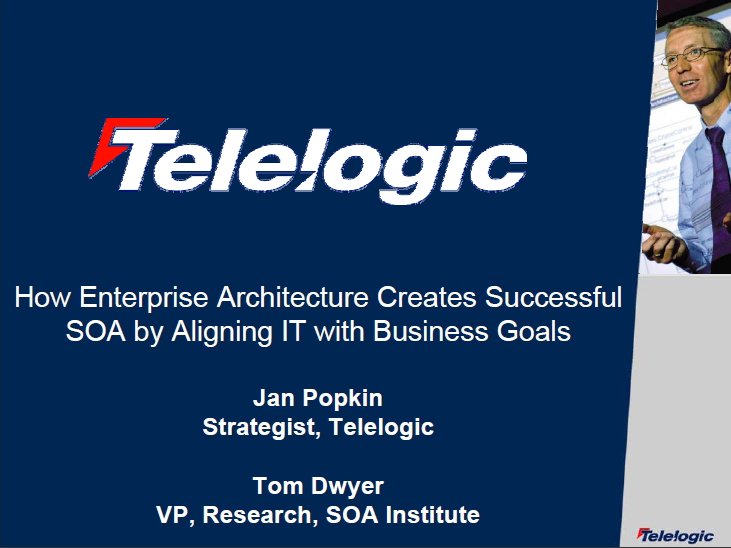
Popkin and Dwyer Show How Enterprise Architecture Creates Successful SOA by Aligning IT with Business Goals
A successful SOA implementation isn’t guaranteed, it comes together when business and IT coordinate their efforts. But bringing IT and the business together can be daunting. They knock heads. When they talk, they don’t seem to speak the same language. To promote the cross-functional, cross-discipline collaboration between business and IT you need to successfully implement your SOA by leveraging the planning, impact analysis, and communication platform established by Enterprise Architecture (EA).

Seven Deadly Sins of Business Rules
“According to CIO magazine, up to 71 percent of IT project failures are caused by an ineffective requirements process.”
Business Rules are the orphan child of the requirements process, and our failure to address this issue continues to contribute significantly to IT failure.
What follows are seven deadly sins that continue to relegate rules to a second class status. We discuss the root cause of the problem, and postulate on potential solutions.
#1: Business rules are captured during design, if at all.

Business Architecture: Driving the Services Portfolio
Service-Oriented Architecture (SOA) looks and sounds very technical. “Architecture” most certainly sounds very specialized. Anything “-Oriented” ranks right up there with “framework” as being steeped in mystery. And what’s a “Service?” It took the business community long enough to figure out what a process was. Now we’re supposed to know what a service is! No wonder SOA has been and still is an IT-driven initiative.
But should it be? IT is certainly involved; someone has to establish the infrastructure. However, should IT decide what services to develop and when?

Expanding SOA Throughout the Enterprise
How are the business and IT environments changing to meet the challenges of today’s fast-paced global business landscape? They are both striving to become more agile. IT is being focused more on increasing profits, revenues and efficiency than just reducing costs. The business is examining ways to improve customer satisfaction and competitive advantage by collaborating throughout the value chain to deliver more innovative and competitive products and services.

BPMS Watch: Step Up Your Modeling Game With Subprocesses
One of the most powerful features of BPMN is the least appreciated… by modelers and tool vendors alike. I’m talking about subprocesses. Most of the process models I have seen would be much improved if they were used more liberally, and more effectively.
In BPMN, a process is viewed as a flow of activities, and an activity – a rectangle in the diagram – can signify only one of two things: a task, meaning it has no subparts of interest to the model, or a subprocess, meaning the activity has subparts of significance to the model.

Defining the Nature and Role of the BPM Professional
As I attend and present at industry BPM conferences, I often survey the participants, asking them to raise their hands if they are from IT departments. Generally, about 30 to 45 percent of the hands go up. I then ask people to raise their hands if they are from the...
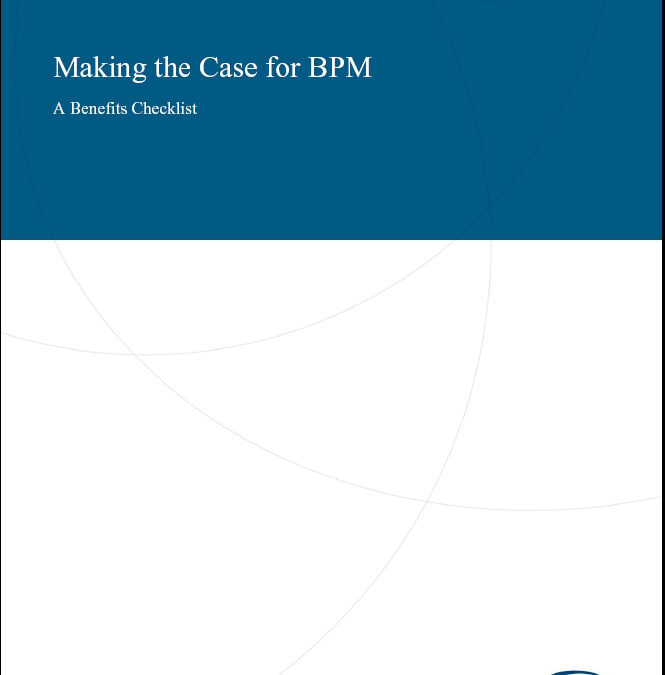
Making the Case for BPM – A Benefits Checklist
There are many options for improving business processes ranging from complete process re-engineering to adopting new process management methodologies or adding new capabilities to existing systems. Lombardi customers believe that BPM is the best investment a company can make in establishing a platform for continuous process improvement.
This paper provides a checklist of BPM benefits and will guide you in making the business case for investing in BPM to drive process improvement.
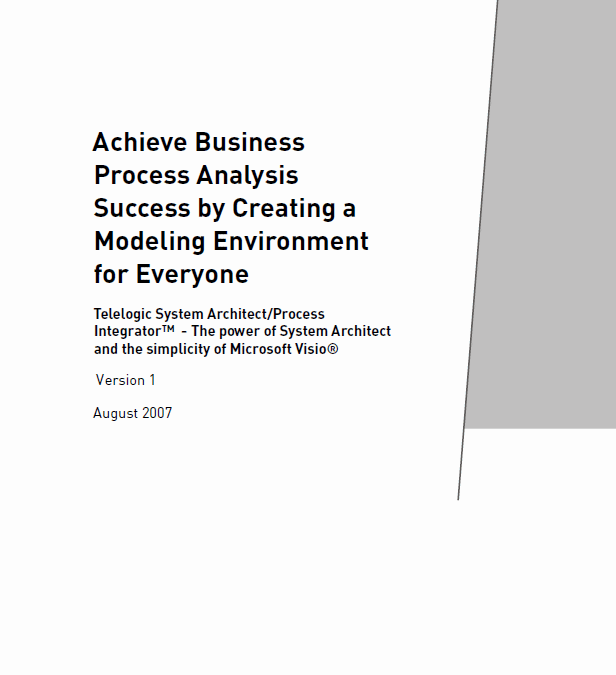
Achieve Business Process Analysis Success by Combining the Simplicity of Microsoft Visio® with the Power of Telelogic System Architect®
Telelogic System Architect/Process IntegratorTM is a creative and unique solution that allows Visio modelers to continue to work with their preferred program while bringing their models under the wider and more powerful business analysis umbrella of System Architect. These models become available to business and enterprise architects who are involved in a core business improvement or enterprise architecture initiative that align IT with business needs. This paper shows how you can achieve business process analysis success by creating a modeling environment for everyone.
Business Process Management – If You Have a Hammer
As a trainer and advocate of standard process languages and standards for metrics I frequently talk to companies that don’t do classic manufacturing; services providers like banks, insurance companies, software companies, etc. Their observation is that they like the value of the standard reference models (SCOR¹, CCOR and DCOR) but they are too manufacturing oriented: “We buy and sell DIY hardware and tools, we don’t make them” and “we provide banking services, we don’t make or ship money”.

When Thinking Service Design…
Within the world of SOA, services are the building blocks, and at the lowest level of the stack. SOA is an architectural style supporting loosely coupled services that enable the construction of many systems that are technology-agnostic. Services become the base of an SOA, and while some are abstract existing “legacy services,” others are new and built for specific purposes.

The Big Six Sigma Myths
Six Sigma has an attractive value proposition. Increase profits and improve customer satisfaction through more effective and efficient business processes. What company could say no to this idea? But, the Six Sigma methodology often is associated with daunting myths that prevent companies from taking advantage of its potential. For example, it’s assumed that Six Sigma is strictly for manufacturing processes, doesn’t work with Business Process Management (BPM).
Innovation? It’s the Customer, Stupid!
“It’s the economy, stupid,” was a phrase in American politics widely used during Bill Clinton’s successful 1992 presidential campaign against George H.W. Bush. It was coined by Democratic Party strategist James Carville in order to keep the campaign on message. Today, just substitute “the customer” for economy, to keep your business innovation strategy on message. Since 2000, innovation has become all the rage in business, and for good reason now that we are competing in a high-change global economy.

BPM/SOA Market Consolidates
![]()
This article originally appeared in the members-only quarterly BPM Strategies Magazine. Join today to receive your own copy.
The convergence of the BPM and SOA markets continues to make news this year and the pace of consolidation has increased in recent months.

BPMS Watch: BPMN Training Revisited
When I launched my course “Process Modeling with BPMN”, I discussed in this column why so many people beginning to “do” BPM were looking for training in modeling, and why that was especially needed for BPMN. Now, having delivered the training for five months, I have a better appreciation of BPMN’s strengths and limitations, a better understanding of what students really want, and what they really need to know about BPMN modeling.
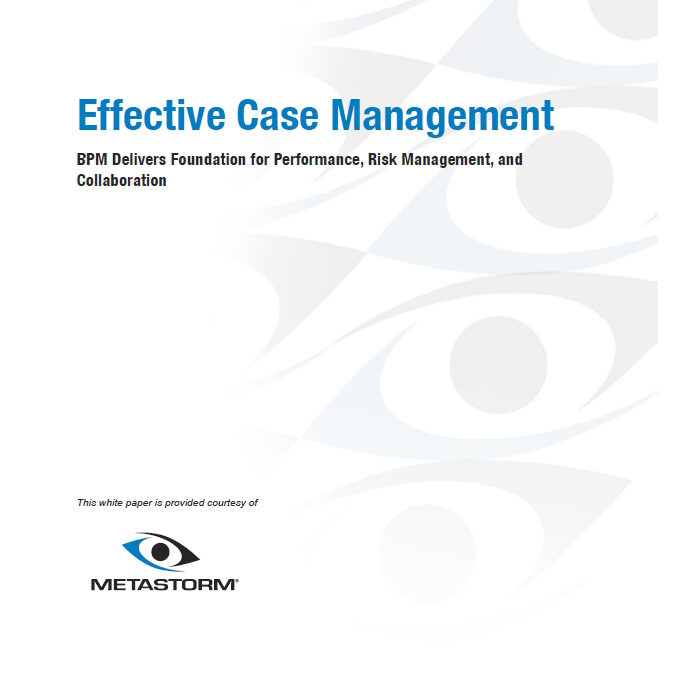
Effective Case Management
Almost all government and commercial organizations practice some form of case management. The “Effective Case Management” white paper defines case management, explains how case management is conducted today in many government agencies, and reveals how to overcome the challenges associated with administrative, investigative, and litigative case management.

Transforming the Management of Government
Truly transforming the management of government business requires both an architectural and process-oriented approach. This transformation is the strategic goal of the 2001 Presidential Management Agenda (PMA) and is enabled by the Federal Enterprise Architecture (FEA). The Business Reference Model (BRM) is one of five reference models in the FEA and is the first layer of the FEA and it is the main viewpoint for the analysis of data, service components and technology specified in the FEA. It is also the primary reference model that establishes the relationship with BPM.

Integrative Thinking: A Path to Instrumented Business Agility
From management and economic theories through technical architectures, many ideas offer the promise of creating a perfect realm for businesses competing in today’s globally networked world.
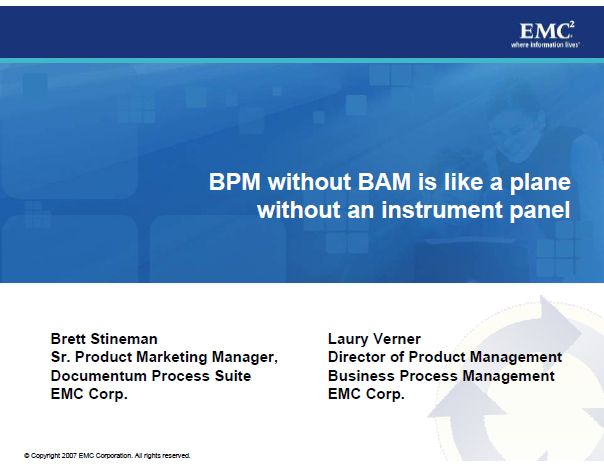
BPM without BAM is like a plane without an instrument panel
Business Activity Monitoring (BAM) has become an essential technology component of a Business Process Management (BPM) solution. After all, what could be more helpful than viewing real-time information about process performance? How about the ability to automatically trigger corrective actions? Or, better yet, being able to diagnose issues before they take place? Just as a pilot wouldn’t fly a plane without being able to view, diagnose and correct its systems, you shouldn’t consider automating processes without being able to have a complete













